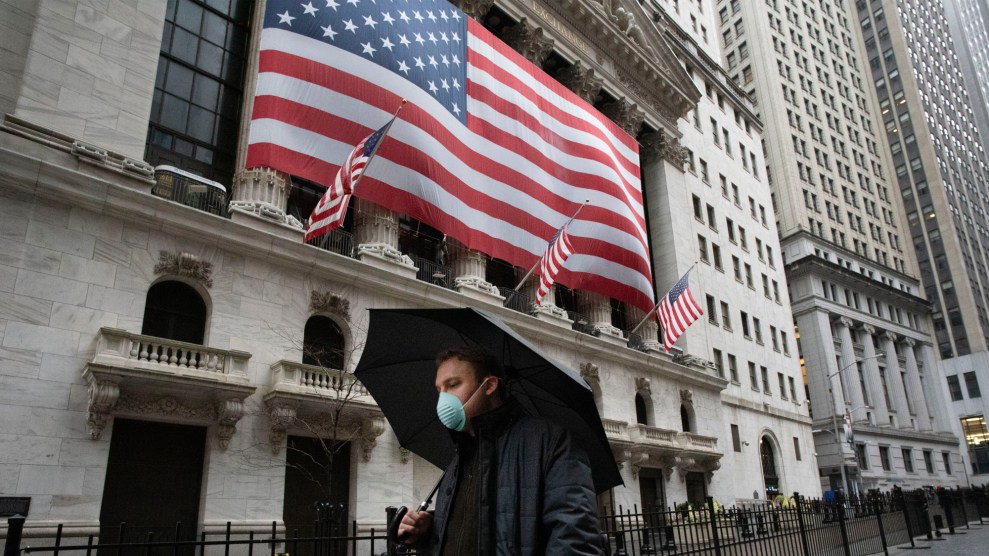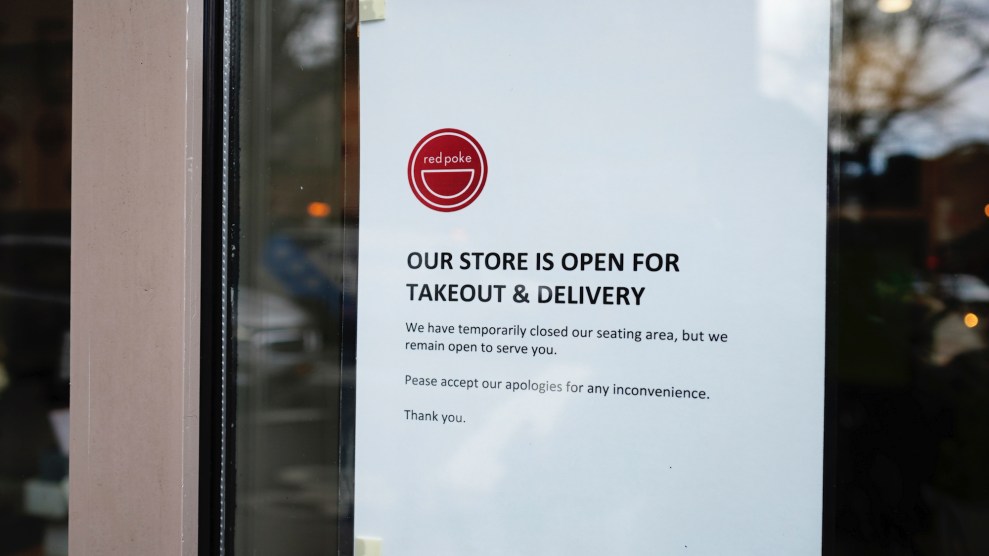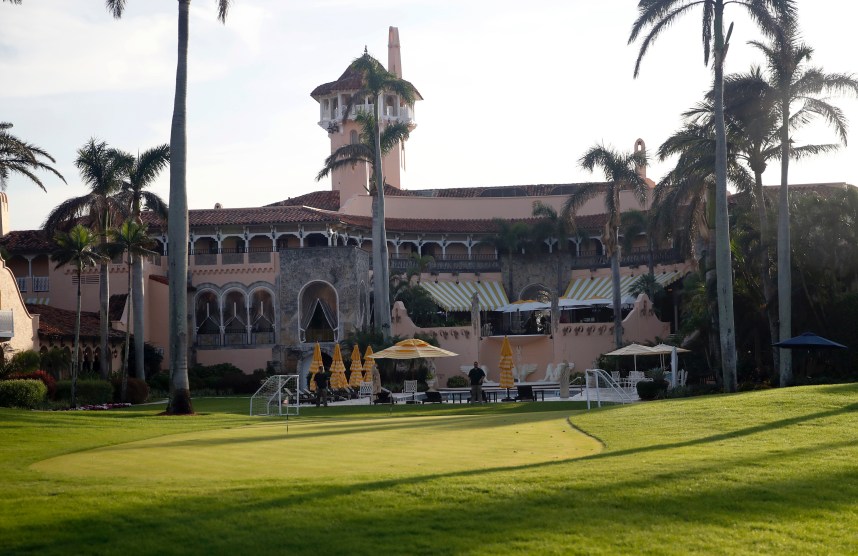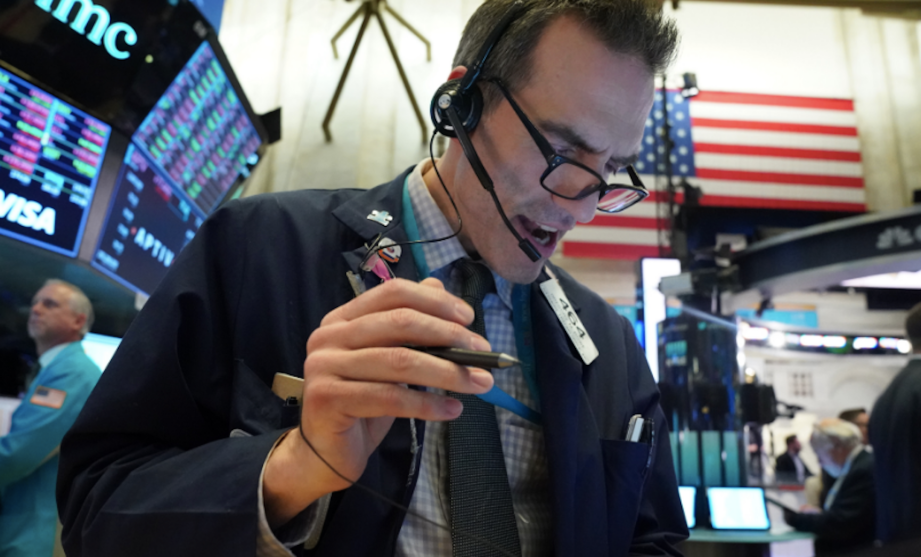
More than 20 million people lost their jobs last month, but the S&P 500 is up 30 percent.Mark Lennihan/AP
This story was published originally by ProPublica, a nonprofit newsroom that investigates abuses of power. Sign up for ProPublica’s Big Story newsletter to receive stories like this one in your inbox as soon as they are published.
Ten weeks into the worst crisis in 90 years, the government’s effort to save the economy has been both a spectacular success and a catastrophic failure.
The clearest illustration of that came on Friday, when the government reported that 20.5 million people lost their jobs in April. It marked a period of unfathomable pain across the country not seen since the Great Depression. Also on Friday, the stock market rallied.
The S&P 500 is now up 30% from its lows in mid-March and back to where it was last October, when the outlook for 2020 corporate earnings looked sunshiny. Companies have sold record amounts of debt in recent weeks for investment-grade companies. Junk bonds, historically dodgy during an economic swoon, have roared back.
If you’re looking for investors’ verdict on who has won the bailout, consider these returns: Shares of Apollo Group, the giant private equity firm, have soared 80% from their lows. The stock of Blackstone, another private equity behemoth, has risen 50%.
The reason: Asset holders like Apollo and Blackstone—disproportionately the wealthiest and most influential—have been insured by the world’s most powerful central bank. This largess is boundless and without conditions. “Even if a second wave of outbreaks were to occur,” JPMorgan economists wrote in a celebratory note on Friday, “the Fed has explicitly indicated that there is no dollar limit and no danger of running out of ammunition.”
Many aspects of the coronavirus bailout that assist individuals or small businesses, meanwhile, are short-term or contingent. Aid to small businesses comes with conditions on what they can do with the money. The sums allocated by the CARES Act for stimulus and expanded unemployment insurance are vast by historical standards. But the relief they provide didn’t prevent tens of millions from losing their jobs. The assistance runs out in weeks, and the jobless live at the mercy of a divided Congress, which will decide whether that help gets extended and, if so, for how long.
It’s a bailout of capital. “If the theory is: Let’s make sure companies are solvent and the workers will be OK, that theory could work. But it’s a trickle-down theory,” said Lev Menand, a former New York Fed economist who now teaches at Columbia Law School.
We do know one thing, he said: “It worked for asset holders.”
The Fed’s efforts, universally praised for their boldness and speed, have come in two stages. First, in February and March, the central bank shored up capital market “liquidity,” which marks how willing investors are to buy and sell. The central bank role is to be a “lender of last resort,” working through banks so they can get money to companies and people.
That expanded in the wake of the 2008 global financial crisis. The Federal Reserve, historically viewed as reserved Brahmins who controlled the money supply, stepped into a new job: “the dealer of last resort,” in the words of economist Perry Mehrling. The Fed bought assets and it bailed out the shadow banking system. “Shadow banking” takes many forms and can mean many things, but generally it describes activities that look like classic banking—taking in deposits and lending out that money—that are undertaken by, for example, a private-equity fund or another institution outside the traditional system of federally insured deposits.
The beneficiaries of this Federal Reserve help in 2008 were money market funds, and short-term lending markets for corporations and financial institutions such as the commercial paper and repurchase agreement markets—all of which had seized up and stopped functioning. Then this year, the Fed came to the rescue of these markets again, doing “such a great job with this that everyone has forgotten this has happened,” Menand said.
Those Fed moves were necessary. But they should not be consigned to the memory hole.
Everyone learned in 2008 that those corners of the markets were vulnerable, but the lessons didn’t stick, apparently. The government tried to install new rules governing different pockets of these markets in piecemeal fashion; financial interests bitterly opposed much of that new regulation. And now, just a short 12 years later, the Fed had to step in to protect these markets and interests once again.
The second stage of the Fed’s extraordinary rescue goes beyond liquidity. It has said it will buy assets it has never bought before. For almost 100 years, the Fed purchased only government bonds. Now it has announced a wide variety of programs to buy various forms of corporate and other debt, either by direct lending, by buying bonds, or buying loans.
The mere announcement that the Fed would do this had an immediate effect, spurring the boom in corporate borrowing.
The Fed didn’t stop with the most solid, safest corporate stalwarts. In early April, it also announced something unprecedented. The central bank said it would buy junk bonds, debt issued by fragile companies, many of which already have crushing debt loads. Sure enough, junk bonds roared back and their cousins, leveraged loans, revived.
In doing so, the Fed backstopped the riskiest markets in the world. The most dangerous investments in the world, it should go without saying, are not owned by middle- and working-class Americans, to whom every politician pledges fealty. No, they are owned by the most risk-seeking investors in the world, the ones that need the highest returns: private equity firms and hedge funds.
But wait, there’s more. The riskiest markets only got more so during the long boom era of the last decade. In the past several years, regulators — especially the former chair of the Federal Reserve, Janet Yellen—repeatedly worried that companies had too much debt. They were concerned how lenders had raced to ease conditions, or covenants, on their loans to elbow out their competitors to fork over money, just as they had in the run-up to 2008. At a moment of record profits, the ratio of corporate debt to earnings steadily rose, while corporate stock buybacks hit records. Those cautions were treated like a parental exhortation to their kids to get off TikTok and brush their teeth.
Yet after all that worry, the Fed then stepped in to save the wealthiest speculators. The mere word that the Fed will make some purchases in this market has swelled these investors’ net worth. Meanwhile, images of mile-long food lines have become common.
In some ways, it’s unfair to blame the Fed. The speed of its actions and its ability to deploy groundbreaking new approaches mask the paucity of its tools. It must work through the capital markets. And only through credit, at that. The Fed has no ability to help regular people directly. “It’s really ill-suited to get money to where it’s most needed and on terms that are the most appropriate,” said Kate Judge, a Columbia law professor and expert in the Federal Reserve.
The House and Senate have much greater powers, the power of the purse and of legislation. Congress could have passed laws that directed help in different ways. Europe has essentially nationalized payrolls, a much more direct form of aid to people who have lost the ability to work. But Congress has been reluctant to use sufficient fiscal measures going back to the 2008 rescue.
What happens if the economy doesn’t come back soon? The Fed’s saddle-ʼem-with-more-debt approach is premised on a sharp and rapid recovery. The virus burns itself out, people go back to work, they buy and sell, and everything snaps back. Companies pay back their loans, and all is forgiven and forgotten.
If the health crisis does not pass quickly, or if the economy does not roar back, the Fed’s actions might prove inadequate. But investors shouldn’t be too worried. They have been taught they can count on the government.














